I wanted to let everyone know that I will be singing in the USF Gospel Choir concert this Sunday, May 4th at 6 p.m. in Xavier Chapel in Fromm Hall. You should come! It'll be fun, and we sound pretty good, if I do say so myself.
Here's a video from last spring's concert. The visual isn't great, but the sound is pretty good. You can find more videos if you poke around YouTube. (I'm not in this because I was abroad at the time.)
Tuesday, April 29, 2008
Jasmine Park
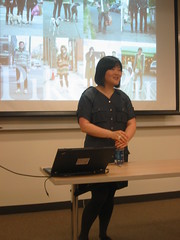
Last Thursday, Jasmine Park of Pike/Pine, a Seattle-based street fashion blog, came to speak to our Digital Literacy class. During the week, Jasmine does program management at Microsoft, but every weekend she walks around Seattle looking for fashionable people to photograph. She told us about how she started out and how her blog has developed since September, 2006, when she started it. She created four rules for herself:
1. Take good photos.
2. Make people look good.
3. Be nice.
4. Only post what she's proud of.
And she outlined three lessons she's learned:
1. Everyone's a critic.
2. Diversity is good (and hard to find).
3. People are nice.
It was in interesting talk, especially because fashion is never something I've paid attention to. It was cool to hear from a part-time blogger. It's still just a hobby for her, as it is for most people. I also liked to hear her thoughts on comments and her decision to delete mean comments in order to create a positive environment.
Moral of the story: If someone stops you on the street and wants to take your picture for a fashion blog, be nice and say yes.
Labels:
blogging,
davies forum,
digital literacy,
jasmine park
Immigration Facts
This afternoon, our Amnesty International group is doing an immigration thing in Harney during dead hour, in conjunction with SOA Watch's series of events (Not For Sale will have something too, so it will be a big ol' social justice party). I volunteered to make handouts, so I thought I'd share them here. They could be better, but they're all right (the info is mainly copied and pasted from a paper I wrote last semester).
Immigration Facts:
Immigration Facts:
- There are over 12 million undocumented immigrants currently living in the United States, over half of whom are from Mexico.(1)
- In 1993, at least 205 immigrants died crossing the border into the U.S., and in 2005 the number was over 460.(2) As more border fences go up and security increases (such as with the 1994 Operation Gatekeeper), immigrants must go through very dangerous places, like the desert, to reach the U.S.(3) People die from suffocation, dehydration, hypothermia, and hyperthermia, among other things.
- 94% of adult male undocumented immigrants work, in contrast with 86% of legal immigrants and 83% of natives. Undocumented immigrants made up about 4.9% of the workforce in 2005.(4)
- In the last five years, Mexican immigrants in the U.S. have sent over $90 billion to Mexico. Mexico receives more money from remittances than tourism, and remittances are Mexico’s second largest source of foreign income, after oil.(5) These remesas help sustain families suffering from poverty.
- Immigrants are HUMAN BEINGS.
- Hoefer, Michael, Nancy Rytina, and Christopher Campbell. “Estimates of the Unauthorized Immigrant Population Residing in the United States: January 2006.” Immigration Statistics. Department of Homeland Security. http://www.dhs.gov/xlibrary/assets/statistics/publications/ill_pe_2006.pdf.
- Hill, Jacob. “Free Trade and Immigration: Cause and Effect.” Council on Hemispheric Affairs. 18 July 2007. http://www.coha.org/2007/07/18/free-trade-and-immigration-cause-and-effect/.
- Romellón, Jorge Santibáñez. “Migration and Borders: The Space for Contradiction, page 2.” Border Battles. 31 Aug. 2006. Social Science Research Council. http://borderbattles.ssrc.org/Santibanez/index1.html.
- Passel, Jeffrey S. “The Size and Characteristics of the Unauthorized Migrant Population in the U.S.” Pew Hispanic Center. 7 Mar. 2006. http://pewhispanic.org/files/reports/61.pdf.
- "Finance And Economics: Counting the Cash; Remittances to Latin America." The Economist 6 Oct. 2007: 102.
Labels:
event,
human rights,
immigration,
social justice,
usf
Sunday, April 27, 2008
stop spam. read books.
I just discovered something so cool I had to put off homework a little while longer and blog about it. I was reading the excellent blog learning.now ("At the crossroads of Internet culture & education with host Andy Carvin"), and I noticed at the bottom of the entry in the space for comments, it required the commenter to type two obscured words, to make sure only real people could comment.
 The first thing that struck me was that it asked for two words, instead of the standard one. The second thing I noticed was that there is an audio alternative for people who are visually impaired. This is fantastic. Then I noticed "stop spam. read books," and I was very intrigued. I went to the reCAPTCHA website and learned more.
The first thing that struck me was that it asked for two words, instead of the standard one. The second thing I noticed was that there is an audio alternative for people who are visually impaired. This is fantastic. Then I noticed "stop spam. read books," and I was very intrigued. I went to the reCAPTCHA website and learned more.
It turns out they work with book digitization projects like the Internet Archive, and when you type in the distorted word, you are reading a word that a computer could not recognize with OCR (I guess the computer knows when it's not reading a word right). They put one word they already know and one they don't, so if you get one right they know you probably got the other one right. They give the same word image to multiple people to get a higher accuracy rate.
So, for example, in the image above, they might already know that the first word is "Germantown," but their OCR software couldn't read the second word, "were." When I type in "Germantown were," I am helping the Internet Archive turn scanned images of a book page into digital text. Awesome. It looks like you can add it to your WordPress blog, among others, but I didn't see a way to attach it to Blogger.
 The first thing that struck me was that it asked for two words, instead of the standard one. The second thing I noticed was that there is an audio alternative for people who are visually impaired. This is fantastic. Then I noticed "stop spam. read books," and I was very intrigued. I went to the reCAPTCHA website and learned more.
The first thing that struck me was that it asked for two words, instead of the standard one. The second thing I noticed was that there is an audio alternative for people who are visually impaired. This is fantastic. Then I noticed "stop spam. read books," and I was very intrigued. I went to the reCAPTCHA website and learned more.It turns out they work with book digitization projects like the Internet Archive, and when you type in the distorted word, you are reading a word that a computer could not recognize with OCR (I guess the computer knows when it's not reading a word right). They put one word they already know and one they don't, so if you get one right they know you probably got the other one right. They give the same word image to multiple people to get a higher accuracy rate.
So, for example, in the image above, they might already know that the first word is "Germantown," but their OCR software couldn't read the second word, "were." When I type in "Germantown were," I am helping the Internet Archive turn scanned images of a book page into digital text. Awesome. It looks like you can add it to your WordPress blog, among others, but I didn't see a way to attach it to Blogger.
Labels:
accessibility,
digitization,
internet archive,
recaptcha,
technology
Thursday, April 24, 2008
A Series of [un]Fortunate Events at USF
This semester's School of the Americas Watch group at USF clearly has their act together, and they, in collaboration with some other organizations, have organized a week of outstanding-looking events which I highly recommend you attend. Here's the information:
April 28
SOLID(arity)
8:30 PM
McLaren Complex
All student teach-in. Awesome presentations, free bread-n-spread snacks, and the opportunity to discuss issues of immigration, fair trade, torture, and the upcoming election with your peers.
We'll be heading over to Ocean Beach afterward for a bonfire.
April 29
Harney Plaza
11:30 AM
Free airbrushed t-shirts! We have some shirts, but first come, first serve. If you'll be late, you can bring your own shirt to be graffitied, too.
There will also be hands on mural painting and an immigration display from USF's chapter of Amnesty International.
April 30
Xavier Chapel
7:00PM
Former Prisoner of Conscience and activist, Father Louie Vitale will give a speech entitled "A Nonviolent Response to Terrorism."
He was recently released from jail for civil disobedience in protest of Fort Huachuca.
Shortly after, he was again arrested at the March 19 anti-war rally in San Francisco.
Carlos Mauricio, founder of Stop Impunity, will speak about his experience as a victim and survivor of torture in El Salvador.
They are both probably 2 of the coolest people ever-- not to be biased or anything.
May 1
Harney Plaza
10:00 AM
Meet to go as a group to the Immigration Rally downtown. Wear your white t-shirt from Tuesday!
Crossroads
6:00 PM
CELEBRATION! Wooo.
*Free Food
*Music
*A short talk from Vietnam War Veteran and SOA Watch activist Charles Liteky.
*A panel on student activism featuring Mike Aguilar, Drea Hightower, Politics Professor James Taylor, and Mel Hackett. Moderated by former USF student Spencer Rangitsch.
*Voter Registration Drive by MEChA
*Information from city organizations like the Committee in Solidarity with the People of El Salvador, Grassroots Campaigns, and the Fellowship of Reconciliation.
April 28
SOLID(arity)
8:30 PM
McLaren Complex
All student teach-in. Awesome presentations, free bread-n-spread snacks, and the opportunity to discuss issues of immigration, fair trade, torture, and the upcoming election with your peers.
We'll be heading over to Ocean Beach afterward for a bonfire.
April 29
Harney Plaza
11:30 AM
Free airbrushed t-shirts! We have some shirts, but first come, first serve. If you'll be late, you can bring your own shirt to be graffitied, too.
There will also be hands on mural painting and an immigration display from USF's chapter of Amnesty International.
April 30
Xavier Chapel
7:00PM
Former Prisoner of Conscience and activist, Father Louie Vitale will give a speech entitled "A Nonviolent Response to Terrorism."
He was recently released from jail for civil disobedience in protest of Fort Huachuca.
Shortly after, he was again arrested at the March 19 anti-war rally in San Francisco.
Carlos Mauricio, founder of Stop Impunity, will speak about his experience as a victim and survivor of torture in El Salvador.
They are both probably 2 of the coolest people ever-- not to be biased or anything.
May 1
Harney Plaza
10:00 AM
Meet to go as a group to the Immigration Rally downtown. Wear your white t-shirt from Tuesday!
Crossroads
6:00 PM
CELEBRATION! Wooo.
*Free Food
*Music
*A short talk from Vietnam War Veteran and SOA Watch activist Charles Liteky.
*A panel on student activism featuring Mike Aguilar, Drea Hightower, Politics Professor James Taylor, and Mel Hackett. Moderated by former USF student Spencer Rangitsch.
*Voter Registration Drive by MEChA
*Information from city organizations like the Committee in Solidarity with the People of El Salvador, Grassroots Campaigns, and the Fellowship of Reconciliation.
Tuesday, April 22, 2008
Reflections on StoneLake Farm
This last weekend our Digital Literacy class went to StoneLake Farm in Humboldt County. StoneLake Farm is owned by USF Media Studies professor/filmmaker Melinda Stone and artist/adventurer/mountain man Francis Lake.

I was struck by the beauty and simplicity I encountered at the farm. It is pretty isolated (we traveled six miles off the highway on a bumpy dirt road that becomes impassable in the winter), and off the electrical grid. They get their power from the sun and their water from the creek that runs through the property. They have goats, chickens, dogs, and some new ducklings.
It was clear that Francis' philosophies about life are deeply ingrained in the way the farm is run. Instead of working against nature, as our industrial world tends to do, it works with nature, in harmony as part of nature.
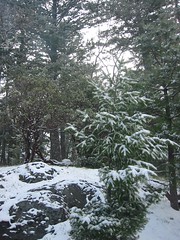

That line we usually place between people and nature is blurred. The intentions of the farm are pure -- it's not about making money, it's about sustainability.
Life on the farm was certainly different from everyday life in San Francisco. It involved a lot of cooking, eating, and chopping wood for the stove that kept us warm in the snowy weather.

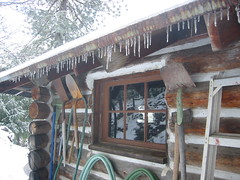
There was no feeling of rushing from one task to the next, another reflection of Francis. When he spoke to us there would often be long pauses, which would normally feel awkward, but didn't. I managed, for the most part, to ignore the homework I brought with me, and I enjoyed some wonderful conversations with my classmates.
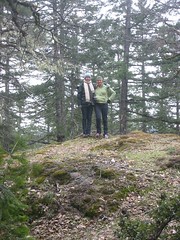
Simple living was a core value of the program I did in El Salvador, and it is a core value of the Jesuit Volunteer Corps, which I will be a part of next year. What does it mean to live simply in a world of consumerism and satisfaction based on material wealth and goods? Some people, like Francis, withdraw from that society and culture and live their own way. For some, that life might be perfect, but I wouldn't want the isolation that accompanies it.
I see two facets of simple living: rejecting materialism and simplifying one's daily life. How do you find a balance between doing all the things you want to do (education, service, activism, spending time with friends and family) and taking a step back, allowing yourself time? I wouldn't consider most of my activities a waste of time, so what could I cut out to allow myself the time to watch the sun set for two hours, as Francis mentioned doing? It's not an easy task, nor is living in harmony with nature when you're in a city and part of American culture, but if we're conscious of our actions, we can do better. I read a book last semester called Affluenza, which describes the all-too-common cycle of working hard, being unhappy at your job, buying material goods to make you happy, working even harder to pay for those things, buying more things to be happy, and so on. That is the lifestyle to avoid, and there's no reason we can't avoid it. Maybe all it takes is a trip to a farm.
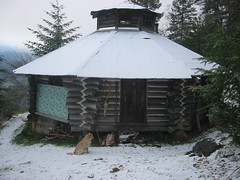
"Live simply, so that all may simply live." - St. Elizabeth Ann Seton

I was struck by the beauty and simplicity I encountered at the farm. It is pretty isolated (we traveled six miles off the highway on a bumpy dirt road that becomes impassable in the winter), and off the electrical grid. They get their power from the sun and their water from the creek that runs through the property. They have goats, chickens, dogs, and some new ducklings.
It was clear that Francis' philosophies about life are deeply ingrained in the way the farm is run. Instead of working against nature, as our industrial world tends to do, it works with nature, in harmony as part of nature.


That line we usually place between people and nature is blurred. The intentions of the farm are pure -- it's not about making money, it's about sustainability.
Life on the farm was certainly different from everyday life in San Francisco. It involved a lot of cooking, eating, and chopping wood for the stove that kept us warm in the snowy weather.


There was no feeling of rushing from one task to the next, another reflection of Francis. When he spoke to us there would often be long pauses, which would normally feel awkward, but didn't. I managed, for the most part, to ignore the homework I brought with me, and I enjoyed some wonderful conversations with my classmates.

Simple living was a core value of the program I did in El Salvador, and it is a core value of the Jesuit Volunteer Corps, which I will be a part of next year. What does it mean to live simply in a world of consumerism and satisfaction based on material wealth and goods? Some people, like Francis, withdraw from that society and culture and live their own way. For some, that life might be perfect, but I wouldn't want the isolation that accompanies it.
I see two facets of simple living: rejecting materialism and simplifying one's daily life. How do you find a balance between doing all the things you want to do (education, service, activism, spending time with friends and family) and taking a step back, allowing yourself time? I wouldn't consider most of my activities a waste of time, so what could I cut out to allow myself the time to watch the sun set for two hours, as Francis mentioned doing? It's not an easy task, nor is living in harmony with nature when you're in a city and part of American culture, but if we're conscious of our actions, we can do better. I read a book last semester called Affluenza, which describes the all-too-common cycle of working hard, being unhappy at your job, buying material goods to make you happy, working even harder to pay for those things, buying more things to be happy, and so on. That is the lifestyle to avoid, and there's no reason we can't avoid it. Maybe all it takes is a trip to a farm.

"Live simply, so that all may simply live." - St. Elizabeth Ann Seton
Monday, April 21, 2008
My dad started a blog!
After much prodding (from me), my father has finally started a blog: Digital Humanist. I'm not sure many of my readers are interested in "classical philology, Biblical studies, patristics, and medieval history," but he will be talking about some technology stuff, which may be of interest. Check it out if you want. At the least, you can see where my nerdiness comes from.
Tuesday, April 15, 2008
Gayla Trail at USF

Last week our Davies Forum speaker was Gayla Trail, creator of You Grow Girl, a website about gardens and gardening. Gayla used to be a designer, and she started the website in 2000 as just something fun to do. She wanted to meet other gardeners like her, who were young and urban, which was not the audience most garden writing focuses on. She said garden writing is dominated by books and magazines, and it is written in a very authoritarian way (this is right, this is wrong, this is how you do it). There's also usually an expectation of space, like a yard, and lots of money. She wanted something different, so she created it herself, and it has become very popular. After a while, she ended up quitting her design work to focus on the website. She talked about the importance of play, and how good it is to be able to have fun and try new things without the pressure of doing well and making money. That's how her site developed the way it did.
To me, Gayla's example shows the power of the internet as a means for creativity and alternative information/messages. I also love the concept of using the internet, which is so "virtual," to share information and experiences about something so earthy and "real life" as gardening.
Labels:
davies forum,
digital literacy,
gardening,
gayla trail,
internet
Monday, April 14, 2008
Service with POH and April Action
In the last couple weeks I've done a bit of enlightening volunteering. Along with other members of Amnesty International at USF, I delivered meals to homebound people with HIV/AIDS and other critical illnesses through Project Open Hand (one of my favorite organizations in SF). I've volunteered a couple times in their Grocery Center, but I had never delivered meals before. We got a couple insulated containers of hot and frozen meals, a map, and a list of clients to deliver to. All the people we delivered to lived in SROs within a few blocks of each other in the Tenderloin. I had never actually been inside an SRO before, and it was intense, horrifying, amazing... I don't know how to express it. The elevators were terrifying. The living conditions were horrible. Still, in one hotel I was waiting in the lobby while some of the other students went upstairs to deliver meals, and I was struck with the community people seemed to have within the building. My roommate, who spends a lot of time with Project Open Hand and is also an intern at St. Anthony Foundation (one of my other favorite organizations in SF), told me that SROs often cost $900-$1000 a month. That's for a single room. Bathrooms are shared with the rest of the floor. That's far more than I currently pay for my own room in an apartment in a pretty nice area of San Francisco.
The other volunteering I did recently was April Action, a service day organized by University Ministry at USF. April Action always has an environmental theme, and last Saturday a bunch of us went to an area of Golden Gate Park where we cleared out blackberry plants that were hurting the magnolias (or something - I wish they had spent a bit more time talking about the purpose of our work). It was going fine, and it was kind of fun except for my arms getting scratched up from all the thorns, until I heard one of the gardeners telling people to stop, saying something like "uh oh, we have a problem." It turned out someone had set up an encampment inside the blackberries. There were some bags of stuff sitting there; it was somebody's home. The gardener called over the woman who was in charge, and I saw her making a phone call, but we kept clearing away the plants. I think those of us who knew what was happening were pretty apprehensive, however. I was glad to hear other students saying they weren't comfortable destroying someone's home. I certainly wasn't. We had a little reflection afterwards, and I brought up the risks of unintended consequences of service. We can be completely well-meaning, thinking we're doing a good thing, but actually do more damage than good.
For anyone interested in social justice and social change, I highly recommend reading Pedagogy of the Oppressed by Paulo Freire. If you're more interested in an 18-page article than a book, check out "Pedagogy for the Children of the Oppressors" by Andrew Christian van Gorder in the Journal of Transformative Education. I don't feel like breaking copyright laws and posting it, but if you're at USF, search for the journal in the library's Journal Finder, then search the article title, and you should find it. It was published in January 2007.
The other volunteering I did recently was April Action, a service day organized by University Ministry at USF. April Action always has an environmental theme, and last Saturday a bunch of us went to an area of Golden Gate Park where we cleared out blackberry plants that were hurting the magnolias (or something - I wish they had spent a bit more time talking about the purpose of our work). It was going fine, and it was kind of fun except for my arms getting scratched up from all the thorns, until I heard one of the gardeners telling people to stop, saying something like "uh oh, we have a problem." It turned out someone had set up an encampment inside the blackberries. There were some bags of stuff sitting there; it was somebody's home. The gardener called over the woman who was in charge, and I saw her making a phone call, but we kept clearing away the plants. I think those of us who knew what was happening were pretty apprehensive, however. I was glad to hear other students saying they weren't comfortable destroying someone's home. I certainly wasn't. We had a little reflection afterwards, and I brought up the risks of unintended consequences of service. We can be completely well-meaning, thinking we're doing a good thing, but actually do more damage than good.
For anyone interested in social justice and social change, I highly recommend reading Pedagogy of the Oppressed by Paulo Freire. If you're more interested in an 18-page article than a book, check out "Pedagogy for the Children of the Oppressors" by Andrew Christian van Gorder in the Journal of Transformative Education. I don't feel like breaking copyright laws and posting it, but if you're at USF, search for the journal in the library's Journal Finder, then search the article title, and you should find it. It was published in January 2007.
Labels:
pedagogy of the oppressed,
service,
social justice,
tenderloin,
usf
Thursday, April 10, 2008
National Library Week
National Library Week is fast approaching! In our Digital Literacy class, we are doing a display in Gleeson Library to celebrate. Hooray!
We've each been charged with taking as much responsibility as we are willing, so here is what I will do.
Books!
I will collect the list of everyone's favorite books, and collect them from the stacks. I will make a list of them (with call numbers) to post on the back wall of the alcove, so patrons can see them even if they've been checked out.
Options: I can make something for patrons to write down their favorite books to recommend. We can talk to Gleeson Gleanings about posting our list and encouraging people to respond with their recommendations.
What will I need from the library? If they want to change the status of the books to "display" in the catalog, we'll need cooperation. If someone (e.g. Vicki Rosen) lets them know what I'm doing ahead of time, I can go to the circ. desk and ask them to do it.
If we want to do the book recommendations on Gleeson Gleanings, we'll need someone to do that post.
Fun!
We've each been charged with taking as much responsibility as we are willing, so here is what I will do.
Books!
I will collect the list of everyone's favorite books, and collect them from the stacks. I will make a list of them (with call numbers) to post on the back wall of the alcove, so patrons can see them even if they've been checked out.
Options: I can make something for patrons to write down their favorite books to recommend. We can talk to Gleeson Gleanings about posting our list and encouraging people to respond with their recommendations.
What will I need from the library? If they want to change the status of the books to "display" in the catalog, we'll need cooperation. If someone (e.g. Vicki Rosen) lets them know what I'm doing ahead of time, I can go to the circ. desk and ask them to do it.
If we want to do the book recommendations on Gleeson Gleanings, we'll need someone to do that post.
Fun!
Tuesday, April 8, 2008
Kevin Epps
Kevin Epps, a filmmaker best known for Straight Outta Hunter's Point, spoke to our Digital Literacy class (along with quite a few other people, many of whom were from the Performing Arts and Social Justice "Company" class, which is doing a production based in part on service-learning they did in Hunter's Point) last Thursday. He was fascinating, and it was wonderful to hear his story. What struck me most is his efforts to give a voice to people who are ignored. Not only does he make media about these people and these communities, but he empowers others to do it as well.
My camera battery is dead at the moment, so I hope Lis will forgive me for using one of hers:
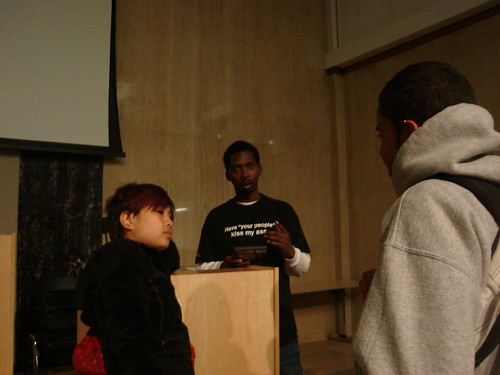
My camera battery is dead at the moment, so I hope Lis will forgive me for using one of hers:

Friday, April 4, 2008
Blogger, Flickr, and Copyright
I decided while I was at it, I would check out the copyright policies for Blogger and Flickr, since those are the two websites where I post my creative (in the loose sense of the term, heh heh) work.
Flickr, via Yahoo!, says in its Terms of Service:
That "solely for the purpose for which such Content was submitted or made available" part is significantly different from YouTube. It seems like basically they're saying, if you upload your work, it's okay for us to display on the website... which is what happens when you upload your work. I might be wrong though.
The Blogger TOS says:
So they can use my work, but again not to the same extent as YouTube. Interesting.
Flickr, via Yahoo!, says in its Terms of Service:
Yahoo! does not claim ownership of Content you submit or make available for inclusion on the Service. However, with respect to Content you submit or make available for inclusion on publicly accessible areas of the Service, you grant Yahoo! the following worldwide, royalty-free and non-exclusive license(s), as applicable:
With respect to photos, graphics, audio or video you submit or make available for inclusion on publicly accessible areas of the Service other than Yahoo! Groups, the license to use, distribute, reproduce, modify, adapt, publicly perform and publicly display such Content on the Service solely for the purpose for which such Content was submitted or made available. This license exists only for as long as you elect to continue to include such Content on the Service and will terminate at the time you remove or Yahoo! removes such Content from the Service.
(Section 9, incl. Paragraph B)
That "solely for the purpose for which such Content was submitted or made available" part is significantly different from YouTube. It seems like basically they're saying, if you upload your work, it's okay for us to display on the website... which is what happens when you upload your work. I might be wrong though.
The Blogger TOS says:
Your Intellectual Property Rights. Google claims no ownership or control over any Content submitted, posted or displayed by you on or through Google services. You or a third party licensor, as appropriate, retain all patent, trademark and copyright to any Content you submit, post or display on or through Google services and you are responsible for protecting those rights, as appropriate. By submitting, posting or displaying Content on or through Google services which are intended to be available to the members of the public, you grant Google a worldwide, non-exclusive, royalty-free license to reproduce, publish and distribute such Content on Google services for the purpose of displaying and distributing Google services. Google furthermore reserves the right to refuse to accept, post, display or transmit any Content in its sole discretion.
(From Section 6, emphasis in the original)
So they can use my work, but again not to the same extent as YouTube. Interesting.
YouTube and Copyright
The issue of YouTube and who controls copyrights came up in two of my classes today, so I decided to investigate.
I took it upon myself to read the Terms of Use, and I think it's within fair use to copy this paragraph:
So there you have it. They can do whatever they want with your work, but it's non-exclusive, so you can still do whatever you want. If you remove your video, they can still keep a copy, but they can't use it anymore. Interestingly, they have a Copyright page within their Help Center, but it doesn't mention this.
On a side note, the issue of jurisdiction for Internet companies has come up in my Communication Law and Policy class, and I noticed the last paragraph of the Terms of Use begins with:
The Terms of Use are actually pretty short and simple, so if you're unsure about anything, you can read it yourself.
I took it upon myself to read the Terms of Use, and I think it's within fair use to copy this paragraph:
For clarity, you retain all of your ownership rights in your User Submissions. However, by submitting User Submissions to YouTube, you hereby grant YouTube a worldwide, non-exclusive, royalty-free, sublicenseable and transferable license to use, reproduce, distribute, prepare derivative works of, display, and perform the User Submissions in connection with the YouTube Website and YouTube's (and its successors' and affiliates') business, including without limitation for promoting and redistributing part or all of the YouTube Website (and derivative works thereof) in any media formats and through any media channels. You also hereby grant each user of the YouTube Website a non-exclusive license to access your User Submissions through the Website, and to use, reproduce, distribute, display and perform such User Submissions as permitted through the functionality of the Website and under these Terms of Service. The above licenses granted by you in User Videos terminate within a commercially reasonable time after you remove or delete your User Videos from the YouTube Service. You understand and agree, however, that YouTube may retain, but not display, distribute, or perform, server copies of User Submissions that have been removed or deleted. The above licenses granted by you in User Comments are perpetual and irrevocable.
(Section 6, Paragraph C)
So there you have it. They can do whatever they want with your work, but it's non-exclusive, so you can still do whatever you want. If you remove your video, they can still keep a copy, but they can't use it anymore. Interestingly, they have a Copyright page within their Help Center, but it doesn't mention this.
On a side note, the issue of jurisdiction for Internet companies has come up in my Communication Law and Policy class, and I noticed the last paragraph of the Terms of Use begins with:
You agree that: (i) the YouTube Website shall be deemed solely based in California; and (ii) the YouTube Website shall be deemed a passive website that does not give rise to personal jurisdiction over YouTube, either specific or general, in jurisdictions other than California. These Terms of Service shall be governed by the internal substantive laws of the State of California, without respect to its conflict of laws principles. Any claim or dispute between you and YouTube that arises in whole or in part from the YouTube Website shall be decided exclusively by a court of competent jurisdiction located in San Mateo County, California.
(Section 14)
The Terms of Use are actually pretty short and simple, so if you're unsure about anything, you can read it yourself.
Labels:
copyright,
digital literacy,
internet,
web 2.0,
youtube
Tuesday, April 1, 2008
Corners
Kelly Quinn, an assistant professor of American Studies at Miami University, came and spoke to our Digital Literacy class on Thursday. She spoke about cities, sidewalks, grids, social intercourse, and public spaces. She was amazing.
This week's assignment is to talk about a place we like, using the concepts of Kelly Quinn and Jane Jacobs to describe why. This was an interesting exercise for me, because while our Jacobs reading made a lot of sense to me, I tend to enjoy parks and relatively isolated places (unsafe as they may be). However, in Kelly Quinn's lecture on Thursday, one thing that stuck out to me in particular was her description of the value of corners, which there are many of when your city is set on a grid. This brought to mind the most famous corner around: Haight and Ashbury.
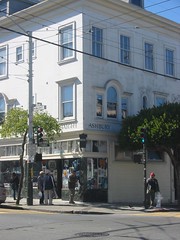
Quinn said that the grid is the most democratic form of urban planning, and that at corners you connect with people who are unlike yourself. One of the things I like about Haight Street is the variety of people you encounter. You find tourists, locals, yuppies, hippies, poor people, wealthy people, young people, and old people, of all sorts of colors and orientations. Jacobs writes about good urban planning being a way to fight segregation and racism (she offers the example of someone in Los Angeles who had never actually seen a Mexican person). If we don't isolate communities from each other, they will interact and come to realize that their differences are superficial.
Jacobs wrote about the importance of eyes on the street in order to maintain safety. Haight Street is always bustling with activity, even until late at night. I would feel safer walking down Haight at night than I would walking back home through the quiet residential streets.

Another very important thing to Jacobs is the anonymity that cities offer. Residents don't want to be best friends with each other, but for a safe and stable environment, there needs to be a level of trust. To me Haight Street feels like it has more of a culture of trust than other busy city streets I know, perhaps because of the quantity of pedestrians and the fact that many of them are there for the sake of being there, rather than just passing through on their way somewhere else. They have a certain level of investment in the neighborhood.
This week's assignment is to talk about a place we like, using the concepts of Kelly Quinn and Jane Jacobs to describe why. This was an interesting exercise for me, because while our Jacobs reading made a lot of sense to me, I tend to enjoy parks and relatively isolated places (unsafe as they may be). However, in Kelly Quinn's lecture on Thursday, one thing that stuck out to me in particular was her description of the value of corners, which there are many of when your city is set on a grid. This brought to mind the most famous corner around: Haight and Ashbury.

Quinn said that the grid is the most democratic form of urban planning, and that at corners you connect with people who are unlike yourself. One of the things I like about Haight Street is the variety of people you encounter. You find tourists, locals, yuppies, hippies, poor people, wealthy people, young people, and old people, of all sorts of colors and orientations. Jacobs writes about good urban planning being a way to fight segregation and racism (she offers the example of someone in Los Angeles who had never actually seen a Mexican person). If we don't isolate communities from each other, they will interact and come to realize that their differences are superficial.
Jacobs wrote about the importance of eyes on the street in order to maintain safety. Haight Street is always bustling with activity, even until late at night. I would feel safer walking down Haight at night than I would walking back home through the quiet residential streets.

Another very important thing to Jacobs is the anonymity that cities offer. Residents don't want to be best friends with each other, but for a safe and stable environment, there needs to be a level of trust. To me Haight Street feels like it has more of a culture of trust than other busy city streets I know, perhaps because of the quantity of pedestrians and the fact that many of them are there for the sake of being there, rather than just passing through on their way somewhere else. They have a certain level of investment in the neighborhood.
Labels:
cities,
davies forum,
digital literacy,
haight street,
jane jacobs,
kelly quinn
Subscribe to:
Posts (Atom)